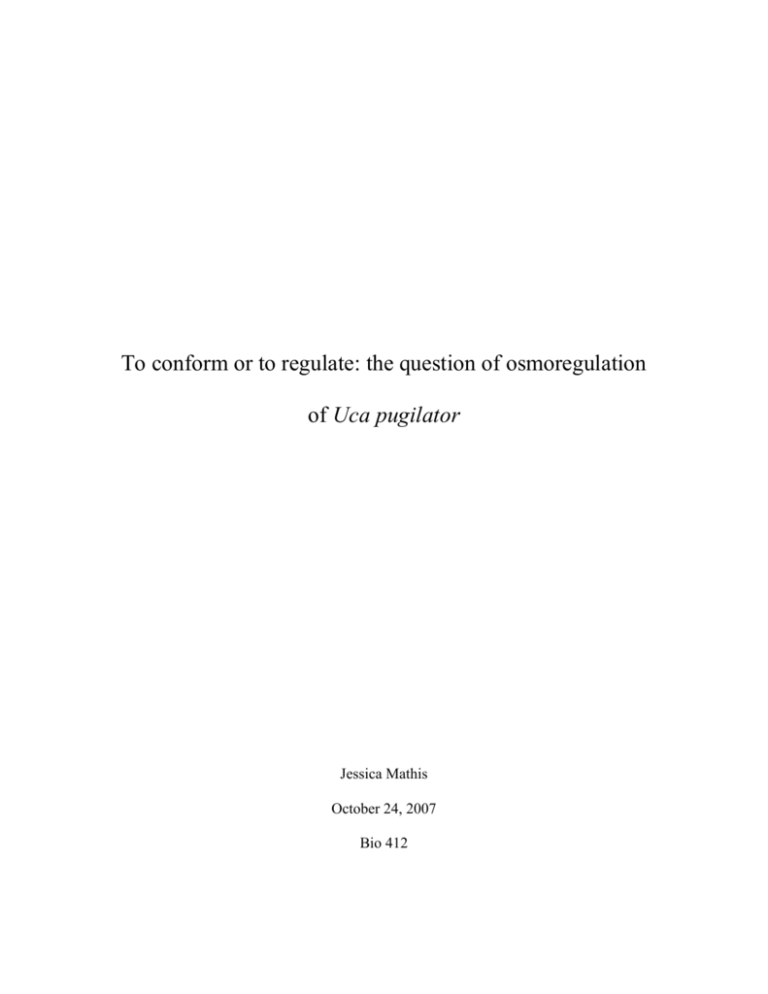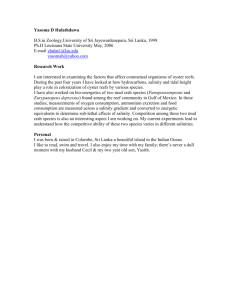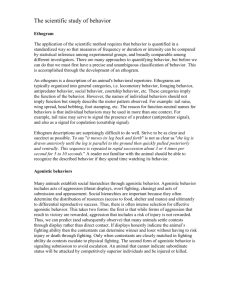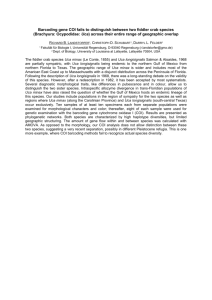To conform or to regulate: the question of osmoregulation of Uca
advertisement

To conform or to regulate: the question of osmoregulation of Uca pugilator Jessica Mathis October 24, 2007 Bio 412 Abstract Osmoregulation of organisms is important to the ability to survive. Some animals conform their internal environment to the external environment while others maintain a constant internal environment no matter what the outside environmental changes might occur. The fiddler crab, Uca pugilator, was used to examine the osmoregularity of brackish-water animals. By using external water samples of the four salinities (25%, 50%, 75%, and 100%) and plasma Na+ concentrations in a flame photometer to obtain an Optical Density of the concentration levels, then converting them to Na+ concentrations to compare levels from the internal environment and the external to determine whether the fiddler crab is an osmoconformer or osmoregulator. The external environment at 25% salinity was on average 63.4425 while the internal environment for the fiddle crab was 134.5417; at 50% salinity the external was 114.3875 while the internal was 139.1898; at 75% salinity the external was 146.3875 while the internal was 138.9071; and at 100% salinity the external was 169.6625 while the internal was 145.7543. The external environment changed drastically with the increase of salinity while the internal environment of the fiddler crab remained at a more constant level throughout the changes of the internal supported that the fiddler crab is an osmoregulator (homeoosmotic organism). Introduction Osmoregulation of organisms is important to the ability to survive. Osmoregulation is a process of the body to maintain a homeostatic condition of the water content within the organism. This is important to the survival of organism because the lack of osmotic regulation could make it possible that organism will intake too much water and become bloated or that water loss to the external environment would cause severe dehydration. Either scenario would cause death among organism. Osmoregulation can occur in two ways. Some animals conform their internal environment to the external environment which is referred to osmoconforming while others maintain a constant internal environment no matter what the outside environmental changes might occur which is referred to as osmoregulating. Osmoconformers can use passive or active processes to regulate water and salinity exchange, while osmoregulators use active processes to keep an internal constant salt concentration no matter the external environment conditions. If organisms are osmoregulators, certain body organs and fluids are important in maintain homeostasis. If the outside environment is hypotonic an organism must release excess water or too water occurs and organisms retain too much water. If the outside environment is hypertonic then water intake in needed to offset the loss of water by osmosis. “The oligohaline or “freshwater species, U.minax, U. spinicarpa and U. longisignalis, possess the lowest average hemolymph osmolality. On the other hand, the euryhaline species, U. speciosa, U. panacea, U. pugilator, and U. pugnax, have much higher average hemolymph osmolality. The Uca species are not uniform in osmoregulatory abilities. There is considerable inter- and intraspecific physiological variation associate with the ecological distribution of each species” (Thurman 2003). The differences in regulatory systems between species can be explained by adaptation of each to their own environment. The freshwater species and the open ocean water species have more stable environments than the brackish-water species like the Uca pugilator. Brackish-water organisms are exposed to the areas where the freshwater and the ocean salt water merge together. High tides, low tides, and the changing of the tides make it hard for organisms to conform to their external environment. The wide changes in the salinity would keep a brackish-water organism constantly changing their internal environment to match their external one. “The excretory organs contributed to the osmoionic regulation of the hemolymph in crabs ... by means of the partial reabsorption or excretion, respectively, of salts from or into the urine” (Zanders and Rojas 1995). Crabs use specialized organs dedicated to the ridding the body of waste to keep the salt concentration in a constant state within the body. “An animal going from the ocean into freshwater usually encounters more variable temperatures and of course enter a less saline medium. The bogy fluids become more dilute or adjustments occur which prevent loss of salts from the body of the animal and keep its blood at a density near that which it had in the ocean. Certain crabs tolerate considerable variations in the salt content of their blood, which contains salts in about the same quantities as the surrounding medium. Hence they readily migrate into brackish or nearly fresh water” (Pearse 1927). Osmoregulators can migrate to different salinities easier that osmoconformers. With the ability to maintain an internal constant salt concentration and the maintenance to minimize water loss lets osmoregulators exploit more habitats. The purpose of this lab is to examine Uca pugilator hemolymph exposed to four different salinities and compare the Na+ concentration to the concentrations of the four salinities of the external environments to determine whether the fiddler crabs are osmoregulators or osmoconformers. Materials and Methods Uca pugilator were exposed to four different salinities; 100% to depict high tide, 75% and 50% to illustrate the changing tides, and 25% for low tide. Three crabs from each salinity were examined. Using insulin syringes hemolymph samples were collected by puncturing the soft integument (tissue) between the segments of the walking legs near the body. After the samples were collected a dilution of 1:200 was made with distilled water. Samples of each of the external water environment were collected, pulse centrifuged to separate out any sediment and also diluted to 1:200 with distilled water. The samples were then vortexed and transferred from large test tubes to smaller ones. The flame photometer was blank to 0.00 using distilled water. Standards of 12.5, 25, 50, 100, and 200 µg/L were analysized. Then each of the samples analysized by using the steps using the flame photometer as described in the Lab Manual (Dr. Crain 2007). Data was recorded by the class for a bigger data set. Crab concentration, water concentration, and crab sex was recorded by all groups and collaborated. Linear regression analysis in Excel was used to determine correlations between environmental and internal Na+ concentrations. Results The hemolymph from each crab was diluted with distilled water and the number gotten from the flame photometer was the optical density. These numbers in return were put into Excel and the standard curve was obtained. The equation for the points that each group was different because of the standard recording with each change of group with the flame photometer. The standard curve equation that my group got was y = 0.0573x + 2.2375 and each of the points were plugged into the equation as y to solve for x. The manipulated equation was x = y-202375 0.0573 Figure 1 shows the difference in the concentration of the internal hemolymph concentration of the fiddler crab compared to the external water salinity concentration. The external environment at 25% salinity was on average 63.4425 while the internal environment for the fiddle crab was 134.5417; at 50% salinity the external was 114.3875 while the internal was 139.1898; at 75% salinity the external was 146.3875 while the internal was 138.9071; and at 100% salinity the external was 169.6625 while the internal was 145.7543. Overall there was an average internal Na+ concentration of 139.5982 and an external Na+ concentration of 123.47. A linear regression analysis in Excel was done to see if there was a correlation between environmental Na+ concentration and plasma Na+ concentration. Figure 2 shows the correlation; there is a relationship, but not an extremely strong one to which the external environment would influence the internal regulation of the fiddler crab. 180 160 140 120 100 80 60 40 20 0 Concentration (microg/L) Environmental concentation (microg/L) 200 Internal(left bar) vs external(right bar) concentration Figure 1: Hemolymph concentration of fiddler crabs in comparison to environmental salt concentration. 150 100 50 y = 8.9809x - 1130.2 2 0 132 R = 0.815 134 136 138 140 142 144 Figure 2: Correlation between Na+ concentation of environment to fiddler crab plasma (with trendline. Without a more equalized collection between males and females an accurate difference cannot be calculated. 146 Plasm a concentration (m icrog/L) 148 Discussion The purpose of this lab was to examine Uca pugilator hemolymph exposed to four different salinities and compare the Na+ concentration to the concentrations of the four salinities of the external environments to determine whether the fiddler crabs are osmoregulators or osmoconformers. Uca pugilator is an osmoregulator. The results suggest that while the external environment changes drastically when the tides changes, the fiddler crabs maintain a more constant internal temperature. There was a wide difference between the numbers of females to males. “Greater experimental variability is found between different batches of crabs than between the sexes of the two species” (Green et al 1959). Other studies of the regulation of the Uca pugilator also support the osmoregulation process. “The ability of these crabs to maintain their sear hypo-osmotic to the medium in both normal and concentrated sea water as shown by the osmotic concentration” (Green et al 1959). Because of the drastic changes in there habitats with the changing tides and salinity level differences, Uca pugilator osmoregulate their internal Na+ concentrations to maintain a homeostatic internal environment. After looking at the information from the data collected, osmoconformers tend to need a constant environment so the organism can conform to the external environment. Extreme shifts in water versus salt concentrations would be dangerous to an osmoconformer because of the drastic changes that a homeostatic system would have to undergo on a continuous basis to keep the body in check. The hemolymph of the fiddler crab, Uca pugilator maintains a relatively constant internal Na+ concentration regardless of the changing environmental surroundings and is an osmoregulator (homeoosmotic organism). Literature cited Crain D.A. 2007. Bio 412: Animal Physiology Laboratory Manual. 36 pgs. Green J.W., Harsch M, Barr L, and Prosser C.L. 1959. The Regulation of Water and Salt by the Fiddler Crabs, Uca pugnax and Uca pugilator. Biological Bulletin 116:76-87. Pearse A.S. 1927. The Migration of Animals from the Ocean into Freshwater and Land Habitats. The American Naturalist 61(676): 466-476. Thurman C. 2003. Osmoregulation in fiddle crabs (Uca) from temperate Atlantic and Gulf of Mexico coasts of North America. Marine Biology 142 (1): 77-92. Zanders I.P, and Rojas W.E. 1995. Osmotic and ionic regulation in the fiddler crab Una rapax acclimate to dilute and hypersaline seawater. Marine Biology 125(2): 315-320.



